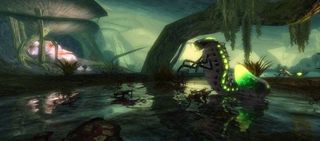Guild Wars 2 dungeons preview

To understand how Guild Wars 2's high-end PvE feels it's necessary to understand how all the ideas behind the game fit together. Without fixed class roles, the emphasis is on player skill and as such encounters have been designed to be more flexible than most modern MMOs. World of Warcraft's boss fights are usually constrained to a particular location because it's by controlling the environment that Blizzard are able to add variety to the traditional tank and spank model. Guild Wars 2 is far less restrained: if your party is able to pull a boss out of their comfort zone, the game won't stop you.
During our run through the Ascalonian Catacombs instance, my party was faced with a pair of bosses who become stronger the closer together they were. The designer accompanying us advised that we try to separate them within the open arena where they spawned, but we quickly found ourselves fought back the way we came, into a narrow corridor that we'd opened by placing a rock on a pressure plate to open a secret door. At this point, a player moved the rock, causing the door to shut and trapping one of the bosses on the other side. After dealing with the first boss, we then re-opened the door and dealt with the other much more easily.
Because player progression isn't tied to specific loot drops, Guild Wars 2 can encourage playstyles that would be considered exploits in other MMOs. This gives players much more freedom to experiment, and with that freedom comes a greater sense of improvisation and teamwork. It can feel very chaotic, but the penalty for death is low enough that it's easy to recover from mistakes quickly. Players who enjoy meticulously planning their pulls will be disappointed - at least on the lower difficulties - but the pace of the action and feeling of freedom is, to my mind, worth the tradeoff.
ArenaNet don't want players to get into a situation where they wipe on purpose because there's no way for them to win, nor do they want people to datamine and document every encounter in the game. Hopefully, this'll mean that Guild Wars 2's set piece battles retain a sense of mystery far longer than those of its rivals. “Our bosses will very rarely use an exact pattern that you have to do to defeat it,” Johanson says. “Instead they're changing their tactics and doing things that you have to react to.”
There'll be eight story mode dungeons when the game ships, and these are instances in the traditional sense - a fixed series of bosses designed for a five-man group and bound together by a narrative. There are still random events, but story mode is about as close to a regular MMO dungeon as Guild Wars 2 gets. They're hard, but they've been designed for groups of strangers and it's fully possible to beat them on your first try.
Once you've finished the story mode of a given dungeon, you can re-enter it in exploration mode. This jumps time forward a notch, and in the case of the Ascalonian Catacombs this means a friendly NPC camp has been set up and there are new problems to deal with. The vengeful spirits that you dealt with the first time are still lurking in the further reaches of the dungeon, and other forces are moving in to stake their claim. Exploration mode is repeatable, but having the narrative move ahead is a nice touch and adds a bit of weight to your achievements in story mode.
Once you reach the friendly camp, you'll be presented with three different problems, such as a boss threatening to collapse part of the dungeon or a treasure to recover. Each of these is advocated by a different NPC and your group then votes on who you're going to support, and that dictates the course you'll take for the rest of your time in the dungeon. This effectively splits every story mode instance into three distinct 'hard modes' - GW2 will have eight maps, but 32 ways to work through them.
The biggest gaming news, reviews and hardware deals
Keep up to date with the most important stories and the best deals, as picked by the PC Gamer team.
Joining in 2011, Chris made his start with PC Gamer turning beautiful trees into magazines, first as a writer and later as deputy editor. Once PCG's reluctant MMO champion , his discovery of Dota 2 in 2012 led him to much darker, stranger places. In 2015, Chris became the editor of PC Gamer Pro, overseeing our online coverage of competitive gaming and esports. He left in 2017, and can be now found making games and recording the Crate & Crowbar podcast.
Most Popular


